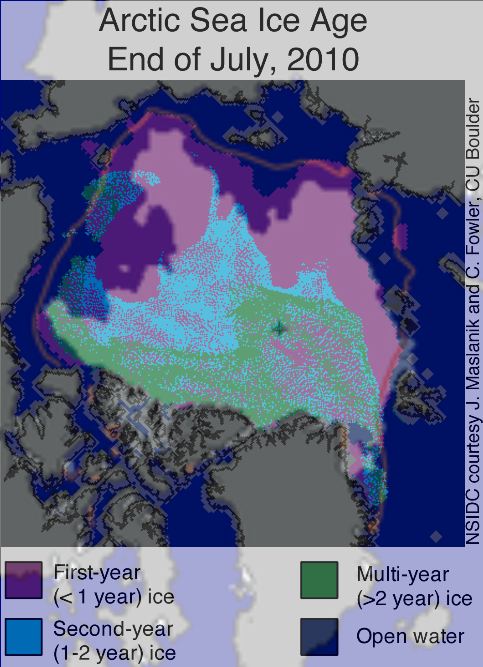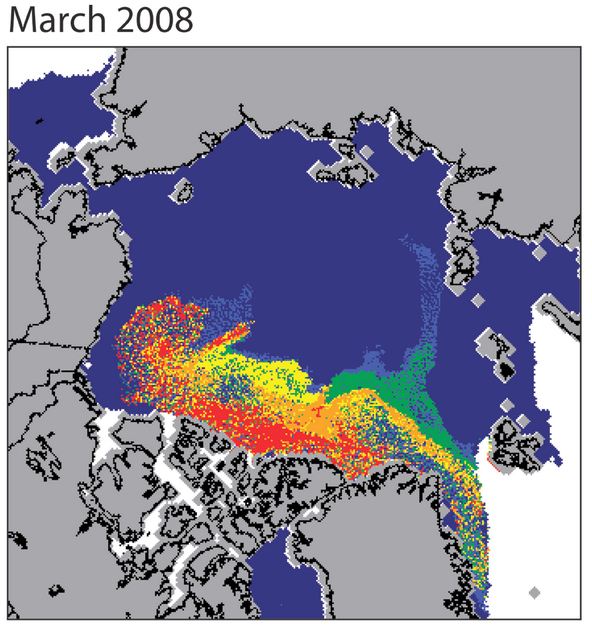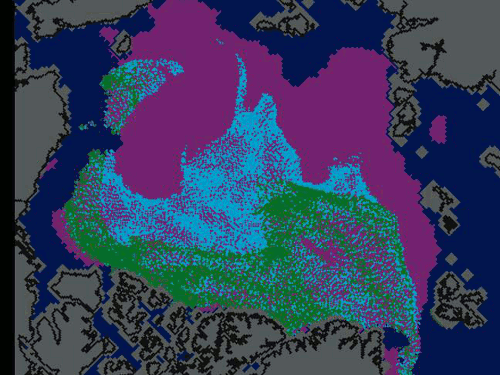The image above is an overlay of NSIDC’s end of July ice age map on their most recent extent map.
There has been some loss of second year and multi-year ice (MYI) since July, but for the most part it is intact.. All of the remaining green and blue ice will be multi-year ice next year, except for any ice which blows out into the North Atlantic over the winter.
Compare that with the amount of MYI in March 2008.
Conclusion. If the Arctic Oscillation stays negative again this winter and ice is retained, we will see a large increase in the amount of thick multi-year ice come spring 2011.





Am I the only one who is unimpressed by all the predicitions being made on both sides of the climate debate? The Met Office tells us we’re going to have a “barbeque summer” and it provides them with convenient publicity for their view that the world is warming. The publicity when the prediction turns out not to be accurate has far less impact, if any. Not least because by that time they have another prediction ready for release.
It is all too easy to make predictions that support one’s worldview. “It’s going to get warmer”. “It’s not going to get warmer”. “There’s going to be more ice”. “The ice will be gone in five years”.
Please can we see these predictions for what they’re worth – not a lot – and evaluate what is actually happening.
This conclusion comes much too soo, cannot even be made at this point, and so is probably made on the basis of wishful thinking.
Much too soon.
Why do the ice thickness overlays use different clours? What thickness does each colour represent? Why chose July and not September, closer to the sea ice extent minimum? Melt rates vary greatly when comparing months. Multi year ice doesn’t necessarily become thick ice. Increased snowfall act as a blanket effectively shielding the ice from the low temperature above. Warming SST’s will continue to melt the ice from below into October or even November. The melt seasons become longer and the freezing seasons shorter, leaving more open water time. (looking at extent-area and volume) The temperature above the ice is not replicated over the open water, where in fact it is closer to freezing point at the surface. The increasing amount of open water will cause more snowfall in winter, muting the winter ice growth wherever present on the ice.
“Conclusion. If the Arctic Oscillation stays negative again this winter and ice is retained, we will see a large increase in the amount of thick multi-year ice come spring 2011.”
I think it is a case of wishful thinking, caveat or not.
I don’t think there is any question that this correct. Julienne wrote the other day :
How much of that may be degraded 4+ year ice? That is, 4+ year ice melted enough to become 2nd and 3rd year ice equivalent. So, less of the 4+ year colour but added to the 2yr 3 yr ice colour.
Any 4+ year ice, if melting in situ, has to go through the equivalent 3, 2 and 1 thickness stages before melting completely.
Just thinking a little further, after the great melt of 2007 of about 1.5 million sq/km there was a partial recovery in 2008 of 0.5 million sq/km and another 0.5 million sq/km in 2009. This would have lead to an increase of 2-year and 3-year ice, that is recovered ice on top of recovered ice. That recovery is now stalled with 2010 already below 2009, with a chance of passing 2008. This also means that all of the 2009 2-year ice has already melted in 2010.
You have to consider the location of the 2+ ice. The fact that there was a lot of late loss of first year ice this year has no effect on the amount of MYI next year. It may affect the amount in 2012.
I still don’t think the argument holds. Julienne said two things (1) The lowest 4+ year ice on record and (2) quite a bit more of 2nd and 3rd year ice. Multi year ice doesn’t disappear in a puff and melting will affect volume and to a lesser extent the extent. If you look back at the late melt start 2010 compared to 2009 which started the melt on March 5. On that date, 2010 measured 14.407 million sq/km and 2009 14.412 million sq/km, level.
On 31 March when the 2010 melt started thr extent was 14.407 million sq/km or a gain of 93,000 sq/km. On that date 2009 was 13.965 million sq/km or 442,000 below 2010. The 93,000 sq/km’s gain of 2010 was not 1 year ice but 26 t0 0 day ice, very thin and quick to melt. It wasn’t until 1 May that 2009 nearly caught up on 2010 with a difference of 30,000 sq/km in favour of 2010. Today 2010 is below 2009 by 347,000 sq/km.
Ice volume is plummetting and at its lowest level of the recorded history since 1979. It is therefore not credible for there to be much more multi-year ice, unless there is ice that isn’t. As for location, the thinner the ice the more mobile. I’ll wait for Cryosat2 to settle the issue. I think that you’ll be proven wrong.
There was very little 4+ ice at the beginning of the summer. By next spring there will be more, because the three year old ice will have another birthday.
I am not convinced that thinner ice is more mobile. There were a lot of days this summer when you could see the thick ice moving, while the thin ice melted in situ. Thicker ice exposes more surface are to the wind, whereas thin ice sits barely above the water.
Why no attempt to incorporate the inevitable Beaufort Gyre and Transpolar Drift? Otherwise you grossly exaggerate the likely extent of multiyear ice in the spring of 2011. After all just compare September 2007 extent with March 2008 second and multiyear ice or September 2008 extent with March 2009 second year ice – a HECK of a lot of old ice escapes over the winter …Get real!